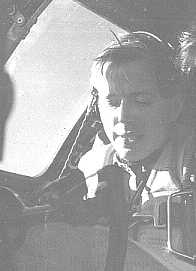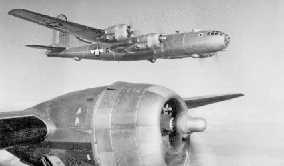
A B-29 Veteran's Speculations about the 8 June 48 Bombing of the Dokdo Islets
Korean War Air Force veteran E.J. McGill flew in combat as a B-29 co-pilot and logged a total of around 700 hours in the aircraft. Mr. McGill did not fly B-29s in June 1948. However, his experience in the USAF with the B-29 in around the same time period might help to shed some light on what might, or might not have happened at Dokdo.

In flight: E.J. McGill in the copilot's seat of the U.S. Air Force B-29 he flew in the Korean War. (c. 1951-52)
Mr. McGill's experience:
|

|
Mr. McGill gives his input on the following issues concerning the 8 June Bombing:
"1948 was before my time; however, I can offer several
educated guesses".
 |
|
Could people have seen the markings (national insignia) on the underside of B-29s at 23,000 feet?
"Absolutely, without a doubt, NOT with the unaided eye".
Eyewitnesses had said that they had been fired at with machine-guns:
"[This] part of the scenario, however, can make sense. We often
flew to gunnery ranges to allow the gunners to practice
firing live ammunition; and sometimes flew low to
accomplish this. I can see the possibility of a few
aircraft making several passes on what they thought was a
designated gunnery range. Bombing and gunnery ranges had
to be cleared via radio contact prior to live firing and
live drops -- primarily because of the possibility of
inflicting damage on our own forces who might also be
using the ranges. I seem to vaguely recall [island] ranges, but am not at all
sure. I remember one island for sure off the Texas Gulf.
Later we used Matagorda Island for B-52 bombing and
gunnery."
Why would live bombs be used for a training excercise?
It makes little sense that 12 bombers
would make a live practice drop in peacetime with anything other
than the "Blue Devil" practice bomb. Normal procedure was
for single aircraft to drop a single 100-pound "Blue Devil"
bomb at a time on a fixed target so the bombardier's
bombing technique could be evaluated. The blue bomb
contained so little explosive that there were often
observers on the ground to triangulate the impact point.
In three years of flying B-29s, I cannot recall a single deviation from
this procedure other than bombing actual enemy targets. To have 12 B-29s salvo on Dokdo would not only be expensive, it would prove nothing insofar as evaluation of the eleven other aircraft were concerned. Nothing would be accomplished that couldn´t be done with practice bombs, except to use up old bombs and, of course, make a tragic mistake. During the Vietnam War we were so short of bombs that we had to buy old WWII Lancaster bombs from the Aussies. They had handles and really looked strange hanging on a B-52. The point here is that the B-29s [that bombed Dokdo] wasted bombs that could have been put to use in both the Korean and Vietnam wars.
The above commentary and photo of E.J. McGill are copyrighted 2001 by E. J. McGill.
E.J. McGill works as a freelance writer. You can see his article, "Black Tuesday Over Namsi," in the October 2001 issue of VFW Magazine.